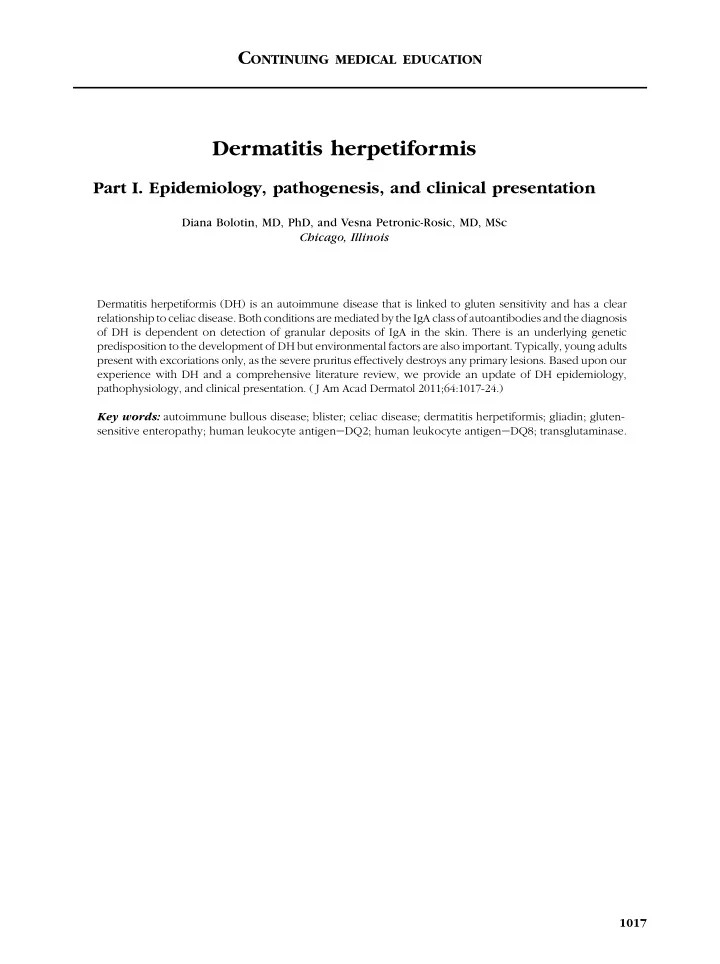

C ONTINUING MEDICAL EDUCATION Dermatitis herpetiformis Part I. Epidemiology, pathogenesis, and clinical presentation Diana Bolotin, MD, PhD, and Vesna Petronic-Rosic, MD, MSc Chicago, Illinois Dermatitis herpetiformis (DH) is an autoimmune disease that is linked to gluten sensitivity and has a clear relationship to celiac disease. Both conditions are mediated by the IgA class of autoantibodies and the diagnosis of DH is dependent on detection of granular deposits of IgA in the skin. There is an underlying genetic predisposition to the development of DH but environmental factors are also important. Typically, young adults present with excoriations only, as the severe pruritus effectively destroys any primary lesions. Based upon our experience with DH and a comprehensive literature review, we provide an update of DH epidemiology, pathophysiology, and clinical presentation. ( J Am Acad Dermatol 2011;64:1017-24.) Key words: autoimmune bullous disease; blister; celiac disease; dermatitis herpetiformis; gliadin; gluten- sensitive enteropathy; human leukocyte antigen e DQ2; human leukocyte antigen e DQ8; transglutaminase. 1017
1018 Bolotin and Petronic-Rosic J A M A CAD D ERMATOL J UNE 2011 studies performed in Europe. 8 Because the popula- Dermatitis herpetiformis (DH) was initially de- scribed by Louis Duhring in 1884. 1 Recent progress tion of Utah has a high proportion of people with Northern European ancestry, the concordance of this in understanding the pathogenesis of this disease has finding with previous studies is not surprising. The led to improved treatment. Linking gluten sensitivity reported incidence of DH is also comparable to that to DH led to the adoption of the gluten-free diet as a reported for other immunobullous diseases, such as key component of treatment. DH is an autoimmune bullous pemphigoid and pemphigus vulgaris. 9 disease, a finding that is strongly supported by A few studies in Asian landmark studies revealing populations have shown the granular deposition of CAPSULE SUMMARY that DH is very rare among immunoglobulin in the skin. 2,3 The immunologic ba- this group and even rarer d Dermatitis herpetiformis is a among African Americans. sis of DH shows a clear rela- multifactorial disease with strong In fact, so few cases have tionship to celiac disease genetic and autoimmune influences been described that no larger (CD). Both conditions are d All patients with dermatitis herpetiformis population-based studies mediated by the immuno- have gluten intolerance have been reported in these globulin A (IgA) class of au- ethnic groups. 10,11 Although toantibodies. Tissue d Hypothyroidism is the most common DH was not considered a transglutaminase (tTG) is autoimmune condition associated with familial condition for many the major autoantigen tar- dermatitis herpetiformis years, that view is now geted in CD, and epidermal changing because a number transglutaminase (eTG) is of genetic studies and epidemiologic reports have the autoantigen most closely linked to DH. IgA recorded familial cases of DH. 12-14 The prevalence anti-eTG is the most sensitive serologic marker for and presentation of DH varies geographically. DH. Many details about the immunologic basis and Northern Europe appears to have the largest number pathogenesis of DH are still emerging in the litera- of cases overall, but DH with onset in childhood ture. Part I of this series will focus on the epidemi- tends to be more common in Mediterranean coun- ology, pathophysiology, and presentation of DH. tries. 15 This may be related to differences in diet or to a genetic predisposition within these populations. EPIDEMIOLOGY Males have a higher prevalence of DH. 8 In fact, Key points most population-based studies to date have found d Dermatitis herpetiformis is most prevalent male to female ratios ranging from 1.5:1 to 2:1. 8 in patients of Northern European descent d Men have a higher prevalence of dermatitis Interestingly, the opposite is true of the prevalence of CD, with female to male ratios ranging from 2:1 herpetiformis than women to 4:1. 16,17 A number of epidemiologic studies have eluci- Most patients report the onset of symptoms dated the incidence and prevalence of DH. Most of during the warmer months of the year, any time from spring to late summer. 8 Whether this finding is these studies focus on individuals of Northern European heritage, both in Europe and the United related to the pathophysiology of the condition is States, in whom this disorder is most common. unclear. The time of onset of DH is variable, with Studies in these populations performed in the late the most common age range at presentation being 1970s to early 1980s report a prevalence range from 30 to 40 years old; however, the age at diagnosis 1.2 to 39.2 per 100,000 people and an incidence varies widely from infancy to the geriatric popula- range of 0.4 to 2.6 per 100,000 people per year. 4-8 In tion. 8,15 Childhood DH is rare, and for many years it addition, a population-based study performed in was grouped with the diagnosis of linear IgA Utah in 1992 documented a prevalence of 11.2 per bullous dermatosis of childhood. Therefore, the 100,000 people and an incidence of 0.98 per 100,000 true prevalence of childhood DH is not well people per year, and both rates are comparable to characterized. PATHOGENESIS From the Section of Dermatology, The University of Chicago. Funding sources: None. Key points Reprint requests: Vesna Petronic-Rosic, MD, MSc, Section of d A strong genetic predisposition to dermatitis Dermatology, The University of Chicago, 5841 S Maryland herpetiformis exists among affected families Ave, MC5067, Chicago, IL 60637. E-mail: vrosic@medicine.bsd. d Human leukocyte antigen e DQ2 and human uchicago.edu. leukocyte antigen e DQ8 are associated with 0190-9622/$36.00
Recommend
More recommend